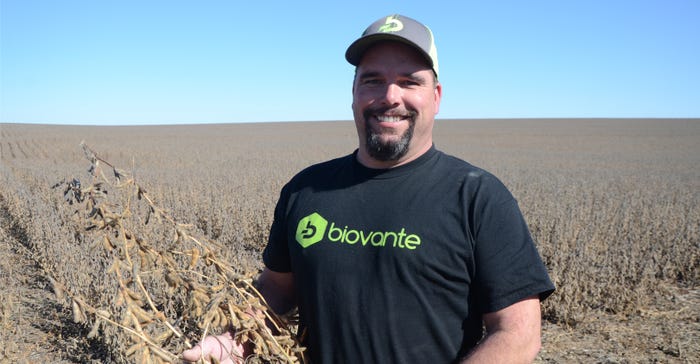
There's plenty of research and discussion on cutting soybean populations in eastern Nebraska. Some growers have had no yield reduction, and therefore improved return on investment, by cutting planting populations as low as 90,000 to 100,000 plants per acre. But for Jimmy Frederick, who farms on the hills and river bottoms of Richardson County in southeast Nebraska, that number sometimes goes even lower.
In October, Frederick set a new dryland record, both statewide and nationally (the national and world record, held by Randy Dowdy at 171 bushels per acre, was reached under irrigation), when he harvested 138 bushels per acre of soybeans. What's most surprising, however, is the planting population on this record-setting field: 50,000 plants per acre, with a final stand count of around 47,750.
By conventional standards, it sounds implausible, if not impossible. But that's until you realize some soybean plants in Frederick's record-breaking field (and elsewhere on his farm) have nearly 50 nodes (including the main stem and laterals) and 400 pods. And some of those pods have as many as five seeds. In many ways, it's a numbers game.
Back before Frederick started experimenting with lower populations, he planted as high as 160,000 seeds per acre — a common practice for growers in eastern Nebraska.
"A couple years ago, I tried decreasing populations and by a big number. We decided to see how low we could push it. They kept holding yields so we kept pushing it lower," Frederick says. "It's all about ROI. When I can decrease population to a certain point, I can reinvest those dollars somewhere else."
In this case, he reinvested in planter upgrades, including active hydraulic downforce, and Precision Planting vDrives and vSet seed meters, which helped improve the consistency of soybean stands.
It's part of the train of thought Frederick has followed since he started working with Chris Masters, president at Biovante, a Missouri-based company focused on biological products.
"We're kind of breaking the mainstream thought that we can drop populations and not worry about losing yield," Master says. "We're making it up by adding more pods. When it comes to numbers, we have to look at how many nodes we have and the number of pods per node."
Even at a lower population of around 60,000, Masters notes with 50-plus nodes per plant, totaling over 350 pods per plant, it's possible to get yields easily over 100 bushels. In fact, those lower populations have a part to play by giving soybean plants room to grow and a bigger solar panel to absorb radiation.
"The system started with the right mindset early on. If you reduce population, apply products early and get light interception deep into the canopy of the plant, we're finding it increases pod counts by 50%, 60%, 100%," Masters says. "Whenever we drop population, we increase energy inputs. If you feed it the right way, that's how you make up for potential yield loss from dropping populations."
And that energy, Frederick says, comes from sugars, which in turn provide carbon. So, along with a starter fertilizer application of 3-18-18, Frederick is also applying several biological products that contain sugars, micronutrients, bacteria and other microbial populations, including Biovante's BioMate and SoyPrime, and others applied later in the year.
"I call biological gatekeepers. They control what gets released from the soil to the plant. Biologicals get to have a say in how nutrients are increased, decreased or stored," Masters says. "As the plant's growing through photosynthesis, the roots will give off root exudates. In order for the plant to receive nutrients from the soil, the plant has to give something up in a microbial exchange. That comes back to biologicals; they open up the gate and allow the nutrients go to the plant."
For example, BioMate includes sugars, as well as two strains of bacteria, that aid in sugar production. These sugars increase plant energy on cool, cloudy days when photosynthesis is barely occurring.
SoyPrime influences existing natural hormones in the plant, helping the plant concentrate in the center of the plant and pulling gibberellic acid (cell elongators) to the exterior of the plant. This can potentially shorten internodes and keep the plant relatively shorter, allowing it to grow a thicker main stem with more lateral branches. This is what Masters and Frederick refer to as the "menorah pattern."
"That goes back to the sugars. If a plant is lacking something, it usually reaches to the sun to produce sugars and starches," Frederick says. "That tells the plant to grow up toward the sun, and elongates the plant and spaces your nodes further apart."
However, improving plant architecture, adding more pods and increasing yield is the sum of many parts, as Masters and Frederick point out. This includes populations, seed spacing, planting the right variety, early applications in-furrow and not applying supplemental nitrogen in-season — which Frederick notes also stimulates the plant to produce more gibberellic acid and elongate the stem.
"A lot of times, it's just testing different things and keeping track of what works and what to keep in the program. That's how you learn from your tissue samples, and how you understand differences in growing degree days with a certain amount of cloudy days in the year, and how different products interact in different conditions," Frederick adds. "You're trying to make a database, and with Mother Nature involved, it can be a struggle."
About the Author(s)
You May Also Like






